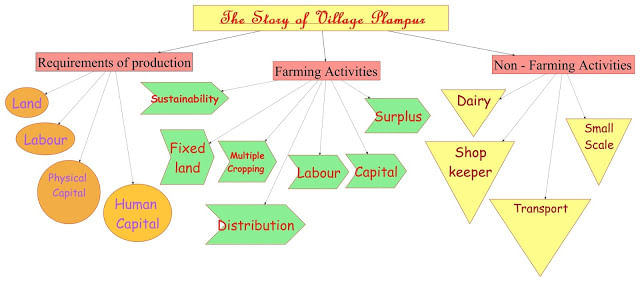Class 9 Exam > Class 9 Notes > Social Studies (SST) Class 9 > Key Concepts - The Story of Palampur
Key Concepts - The Story of Palampur | Social Studies (SST) Class 9 PDF Download
| Table of contents |

|
| Village Palampur |

|
| Main Production Activities |

|
| Factors of Production |

|
| Important Changes in Farm Activities |

|
| Labor |

|
| Capital |

|
| Sale of Surplus Farm Products |

|
| Non-farm activities |

|
Village Palampur
Palampur is a small village having about 450 families. It is 3 km away from Raiganj — a big village. Shahpur is the nearest town to the village.
Main Production Activities
- Farming is the main production activity in the village Palampur.
- Most of the people are dependent on farming for their livelihood.
- Non-farming activities such as dairy, small-scale manufacturing (e.g. activities of weavers and potters, etc.), transport, etc., are carried out on a limited scale.
Factors of Production
- Land, labour, and capital are the basic requirements for the production of goods and services which are popularly known as factors of production.
- Land includes all free gifts of nature, e.g., soil, water, forests, minerals, etc.
- Labour means human effort which of course includes physical as well as mental labour.
- Physical capital is the third requirement for production.
- Physical capital includes fixed capital (e.g. tools, machines, building, etc.) and raw materials such as seeds for the farmer, yarn for the weaver.
Question for Key Concepts - The Story of PalampurTry yourself:Which of the following is not a factor of production?
View Solution
Important Changes in Farm Activities
Land
- Land area under cultivation is virtually fixed.
- However, some wastelands in India has been converted into cultivable land after 1960.
- Over the years, there have been important changes in the way of farming, which have allowed the farmers to produce more crops from the same amount of land.
- These changes include:
(a) Multiple cropping farming
(b) Use of modern farming methods. - Due to these changes (in the late 1960s) productivity of land has increased substantially which is known as Green Revolution. Farmers of Punjab, Haryana and Western Uttar Pradesh were the first to try out the modern farming methods in India.

Labor
- After land, labour is the next basic factor of production.
- Small farmers provide their own labour, whereas medium and large farmers make use of hired labour to work in their fields.
Capital
- After land and labour, capital is another basic factor of production. All categories of farmers (e.g. small, medium, and large) require capital.
- Small farmers borrow from large farmers or the village money lenders for the traders who supply them various inputs for cultivation.
- Modern farming requires a great deal of capital.
Sale of Surplus Farm Products
- Farmers produce crops on their lands by using the three factors of production, viz. land, labour, and capital.
- They retain a part of produce for self-consumption and sell the surplus in the nearby market.
- That part of farm produce that is sold in the market is called a marketable surplus. Small farmers have little surplus output.
- It is the medium and large farmers only who have substantial surplus produce for selling in the market.
Non-farm activities
- Out of every 100 workers in the rural areas in India, only 24 are engaged in non-farm activities.
- There is a variety of non-farm activities in the village.
- Dairy, small-scale manufacturing, transport, etc., fall under this category.
Watch the video below for detailed explanation:
The document Key Concepts - The Story of Palampur | Social Studies (SST) Class 9 is a part of the Class 9 Course Social Studies (SST) Class 9.
All you need of Class 9 at this link: Class 9
|
55 videos|637 docs|79 tests
|
FAQs on Key Concepts - The Story of Palampur - Social Studies (SST) Class 9
| 1. What are the main production activities in Palampur? |  |
Ans. The main production activities in Palampur are agriculture and farming. The villagers cultivate various crops such as wheat, maize, sugarcane, etc. They also rear animals like cows, buffaloes, goats, and sheep.
| 2. What are the factors of production in Palampur? |  |
Ans. The factors of production in Palampur are land, labor, capital, and entrepreneurship. Land is used for cultivation, labor is required for farming and other activities, capital is used to purchase seeds, fertilizers, etc., and entrepreneurship is necessary for the management and organization of production.
| 3. What are the important changes in farm activities in Palampur? |  |
Ans. The important changes in farm activities in Palampur include the use of modern machinery like tractors, threshers, etc., the adoption of better irrigation techniques, the use of high-yielding variety seeds, and the shift towards commercial farming.
| 4. How are surplus farm products sold in Palampur? |  |
Ans. Surplus farm products in Palampur are sold in the nearby markets or to the traders who come to the village to purchase the products. The villagers can also sell their products to the government agencies like Food Corporation of India.
| 5. What are the non-farm activities in Palampur? |  |
Ans. The non-farm activities in Palampur include small-scale industries like spinning mills, brick kilns, etc., transportation services like rickshaws, carts, etc., and services like shopkeepers, teachers, doctors, etc. These activities provide employment opportunities to the villagers and contribute to the overall development of the village.
Related Searches





















